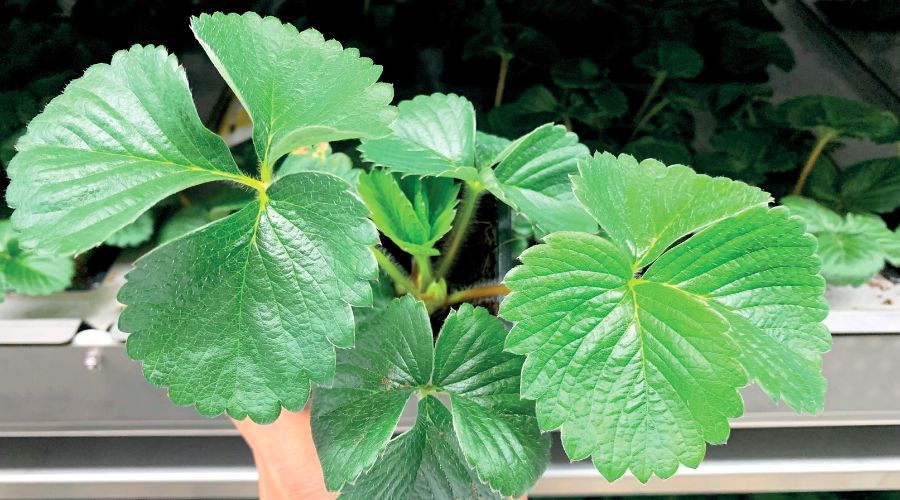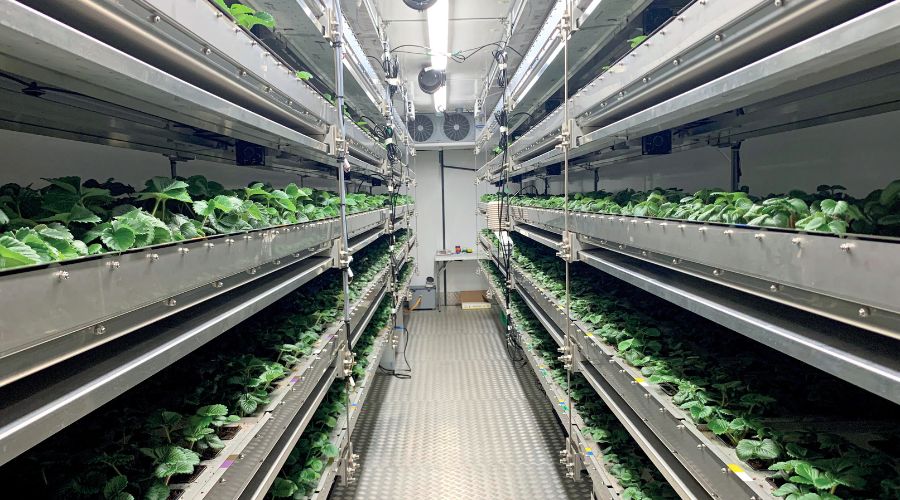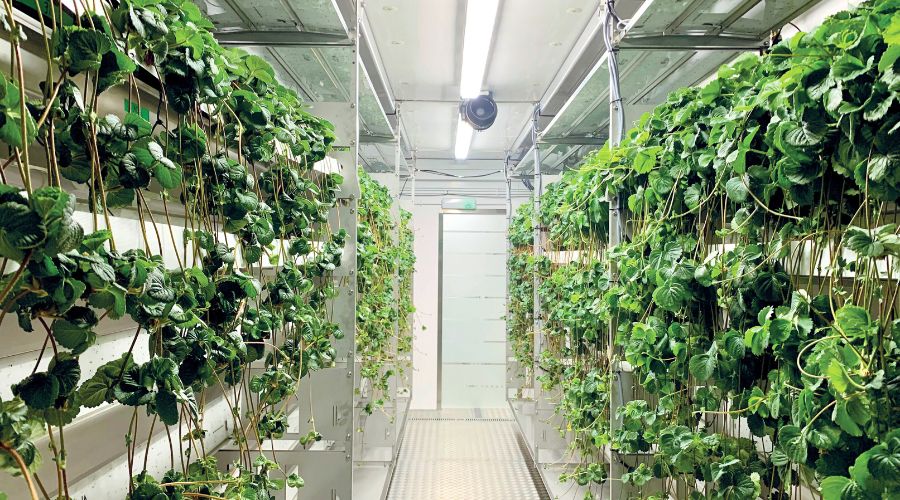Future potential for vertical farming of strawberries
23rd November 2024
NIAB’s Katia Zacharaki and Dr Mark Else outline why vertical farming of strawberries has not always been a commercial success and explain how NIAB is using this technology to improve the yield potential and performance of strawberry plants propagated using this approach.

There has been a lot of buzz around the concept of “vertical farming,” especially when it involves a particular crop like strawberries. Vertical farming is often perceived as a challenging venture due to its high capital expenditure (CapEx) and operational expenditure (OpEx).
Strawberries, being a high-value crop that is relatively compact, appears to be an excellent candidate for vertical farming. Indeed, over the past decade, several attempts have been made to grow strawberries commercially in indoor vertical farming conditions for their highly-flavoured fruits, although these have not always been successful. In fact, some of these attempts resulted in spectacular failures, garnering negative publicity for both the companies and the industry.
The general perception might be that strawberries cannot be grown in an indoor environment, that it’s too expensive, that the technology is not quite there yet, or perhaps that the fundamental physiological responses of the crop are not yet understood well enough. While these speculations may hold some truth, several companies and research institutions have successfully grown strawberries for fruit production in controlled environments for some time now.
Conducting studies
One example is NIAB, where researchers have been conducting studies on soft fruits in controlled growth rooms for over 20 years. Other groups could also claim to have been working on strawberry cultivation in vertical farming, or Total Controlled Environment Agriculture (TCEA), the term that scientists prefer to call the practice of growing plants indoors using artificial light as the sole source of photosynthetic radiation (light).
In addition to research institutions, some commercial companies working on the crop have produced groundbreaking findings. However, due to the cost and financial benefits involved, these results are often not made public.
While some companies have managed to use these findings for commercial gain, many start-ups have ended up failing, often quite dramatically. These notable bankruptcies and dissolutions are not caused by any single reason but by a combination of factors. Frequently, the business plans underestimate the unpredictable ‘biological’ responses of plants. Entrepreneurs from fields like engineering or finance often make the mistake of using overly optimistic scenarios as their baseline, leading to financial difficulties even after securing significant investments.
The issue was not their ability to attract funding, but perhaps that they failed to employ the expertise of horticulturists or plant scientists or to heed their advice. Oftentimes, it seems these plant and crop experts have not been consulted as completely as the technology providers, with the inevitable result that attempts to grow strawberries in TCEA conditions and systems suitable for the production of leafy salads and herbs have failed.
We do believe, however, that this is changing, and that the remaining companies, as well as new entrants in the field, are now giving biological factors the attention they deserve in their planning and decision-making processes.
Returning to successful TCEA strawberry ventures, two companies worth mentioning are Agricool (Paris) and Oishii (New York). Agricool was a pioneer, being the first company globally to grow strawberries in containers and sell them in stores in Paris.

Unfortunately, Agricool faced financial challenges and discontinued operations in 2022. Oishii, on the other hand, has focused on premium, high-end marketing, selling eight strawberries for $50. It recently raised $134 million in its Series B funding round. Oishii’s success stems from its understanding that growing strawberries in TCEA is significantly more expensive than conventional cultivation.
The higher costs are mainly due to the higher light intensity and more stringent environmental controls compared to crops like leafy greens, leading to higher energy bills. This means that, currently, a TCEA strawberry company can only be profitable by moving away from the commodity market and positioning its product as a niche, premium offering. This is how Oishii has achieved its success.
Propagation of strawberry plants
In addition to the fruiting stage, TCEA could also add value in the propagation of strawberry plants, especially given the current state of the supply chain and industry. The principle of vertical farming is based on using multiple and stacked growing layers in order to maximise each square meter of growing space.
Propagation is a stage where plants are grown to a relatively short height at high planting densities, which aligns well with the vertical farming model.
In the case of strawberries, imagine propagating plants year-round in indoor vertical farms, producing high-health, pest- and disease-free tray plants with a greater and more consistent cropping potential, all produced with fewer plant protection products and less waste. Do you think that there is a market for this product? We think there is. The end customer of these high-health, high quality propagules could be the existing soft fruit sector who grow in polytunnels and CEA, and perhaps the new generation of TCEA strawberry growers.
With this unique selling point in mind, NIAB is working on a £1.8m project to develop the infrastructure and methodology for propagating strawberry plants in indoor vertical farming or TCEA. NIAB is collaborating with a number of leading companies in the industry, from commercial soft fruit growers (Clock House Farm and Hugh Lowe Farms), propagators (Blaise Plants and Linton Growing) sensor providers (Delta-T) and substrate (Cocogreen) suppliers, as well as Reading University, while the project is led by Vertical Future.
This three-year project is using TCEA to produce high-health June-bearing and everbearing cultivars. The experiments begin with tissue-cultured plants, which are then raised to become the mother plants.
These mother plants are grown in Vertical Future’s prototype strawberry propagation facility at NIAB East Malling using LED lighting, with the aim of accelerating runner production and generating healthier daughter plants in a more consistent environment. The daughter plants have been planted in coir substrate and moved to a second compartment, where they are currently undergoing flower induction treatments before being exposed to chilling conditions.

The project will compare the marketable yield and fruit quality of these high-health plants with that from commercially-propagated plants from our partner propagators. These comparative trials will take place in three production environments: conventional polytunnels, glasshouses, and TCEA systems. After all, the main clients of our approach will likely be strawberry growers, whether they use polytunnels or glasshouses, until TCEA strawberry cultivation for fruiting becomes more prevalent.
The future
At NIAB, we believe that recent developments in vertical farming when coupled with expert plant sciences can benefit the wider horticultural sector by accelerating specific parts of the cultivation process, such as propagation, while also enabling a better understanding of the fundamental responses of plants to their environment.
This, in turn, will enable us to fine-tune specific attributes through judicious tweaking of the growing environment, and to ensure that all resources, including energy, are used most efficiently. This knowledge will allow us to collectively improve commercial cultivation practices in future. In many traditional production systems, marketable yield and quality improvements have reached a plateau, and only through new technologies and methods will we be able to achieve further progress. It is clear to us that TCEA is one of those key innovations.
Read more fruit news.
